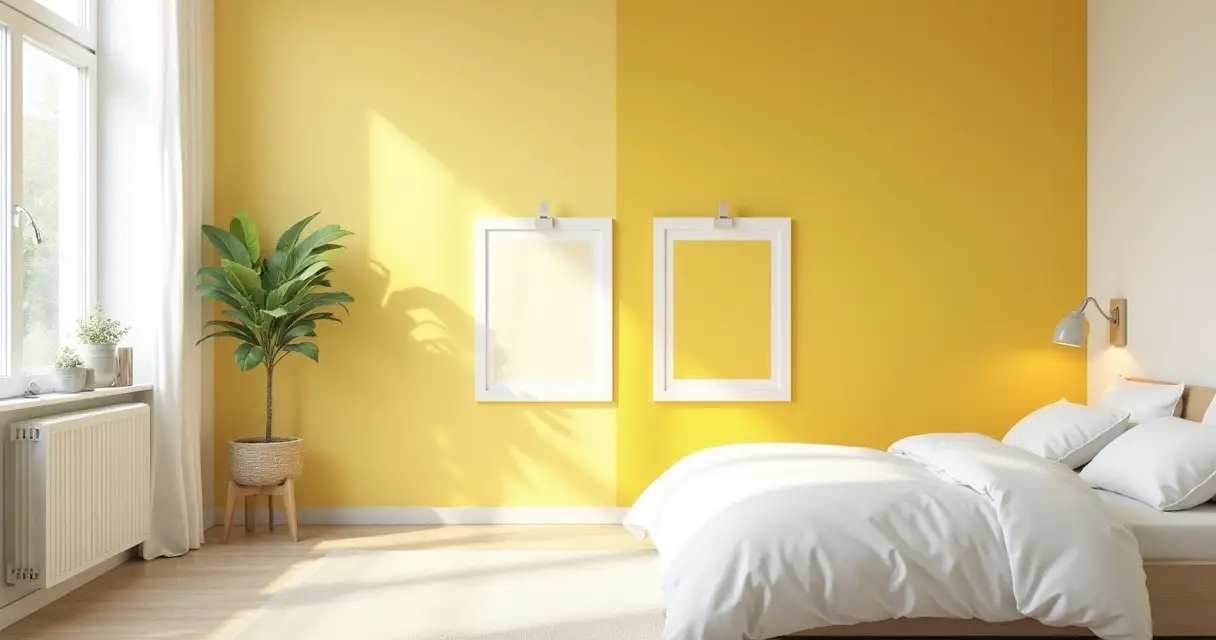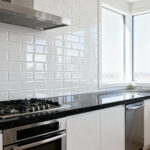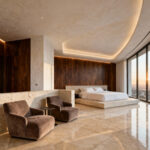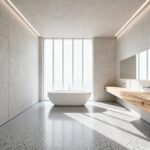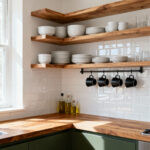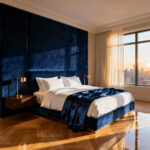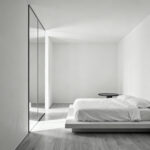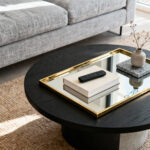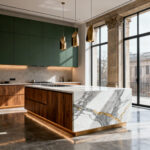I had a client last week, a wonderfully sharp woman, who showed me a tiny paint chip she’d picked up. It was a lovely, optimistic yellow, and she was ready to commit to painting her entire master suite with it. I see this all the time—people fall in love with a color under the harsh, fluorescent lights of a hardware store and believe they’ve found the one. Nothing makes you consider the nuances of color quite like watching someone almost make a five-figure mistake.
That moment of impulse, of falling for a swatch in a vacuum, is exactly what separates an accidental accumulation of decor from intentional, capital-D Design. Yellow, more than any other color, is a chameleon. It doesn’t just sit on your walls; it converses with the light, the architecture, and every single object in the room. Getting it right isn’t about finding a pretty color. It’s about orchestrating an atmosphere. Let’s talk about how to do it properly.
Planning Your Sunny Sanctuary: Laying the Yellow Foundation (Part 1)
Before you even think about picking up a paintbrush, we need to lay the groundwork. This is the part everyone wants to skip, and it’s the single most important phase. Getting the foundation right means the rest of the design will fall into place with elegance and ease.
1. Evaluate Your Room’s Natural Light for Optimal Yellow Shade Selection
The biggest mistake people make is choosing a yellow based on the swatch alone. That little two-inch square is the source of more design regret than anything else I can think of, because yellow isn’t a static color—it’s a reactive one. It feeds on light. A soft, buttery yellow that looked serene in the store can become a screaming, aggressive lemon in a sun-drenched, south-facing room. In a north-facing room with cool, indirect light, that same beautiful shade can look sad and almost greenish.
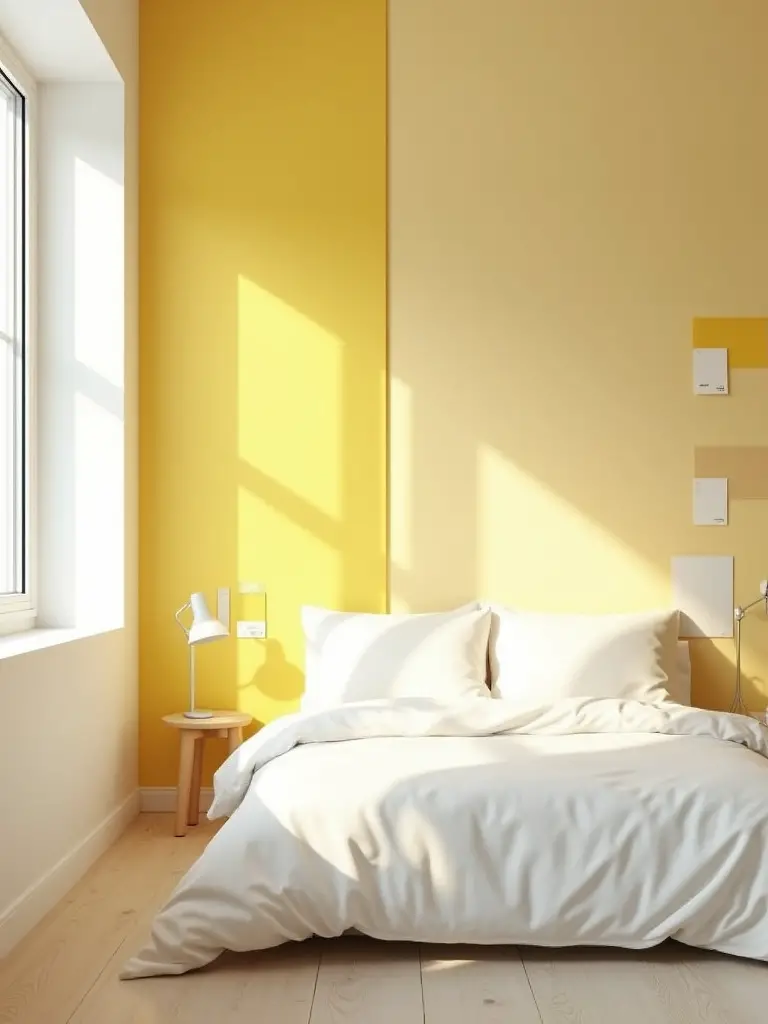
Here’s the only way to do it right, and it’s non-negotiable. Buy sample pots of two or three shades you’re considering. Go to a quality paint supplier like Farrow & Ball or Benjamin Moore where the pigments are complex. Paint enormous swatches, at least 18 inches square, on the main wall you see when you walk in and on the wall adjacent to your primary window. Then, you live with them for at least two full days. Watch them at dawn, in the harsh light of noon, and as dusk settles in. The shade that still feels right in every light is your winner.
Now that you’ve found the perfect yellow that plays nicely with your room’s light, we need to decide exactly what feeling you want to evoke.
2. Determine Your Preferred Yellow Tone: Warm Gold, Soft Pastel, or Vibrant Ochre
The “idea” of yellow is singular, but its execution is infinitely varied. Are you envisioning a serene, calming retreat or an energizing, vibrant space to start your day? The specific tone you choose is the primary lever you’ll pull to control the room’s mood. A soft, creamy pastel whispers tranquility and is perfect for a restful primary suite. A deep, rich ochre or gold, on the other hand, speaks of warmth, history, and sophistication. It grounds a space beautifully.
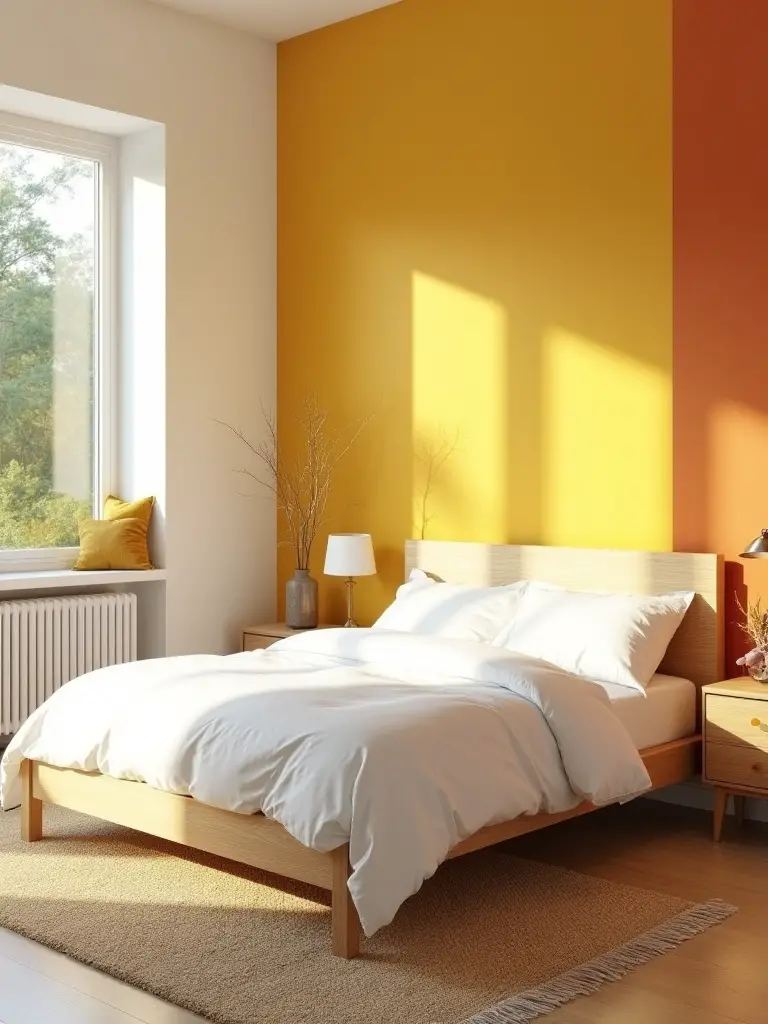
I had a client creating a guest room, and she wanted it to feel welcoming but not childish. Everyone told her to use a pale, “safe” yellow. Instead, we chose a muted, earthy ochre for the wall behind the headboard. Paired with cream linens and dark wood, the room felt less like a spare room and more like a suite in a boutique European hotel. Don’t let yourself be boxed in by the most obvious choices; consider the feeling first, and let that guide you to the right tone.
Once you have a general tone in mind, it’s time to gather your thoughts and ensure every element will work in harmony.
3. Create a Mood Board to Visualize Your Desired Yellow Palette and Complementary Colors
Can I tell you a secret? Every single high-end project I’ve ever designed started as a mess of clippings, fabric swatches, and paint chips on a piece of foam core. A mood board is not a frivolous step for creative types; it is an essential tool to prevent expensive mistakes. It’s where you audition your ideas. It allows you to see how your chosen ochre actually looks next to that navy velvet you’re considering for the headboard, or how a buttery pastel interacts with the brass accents you want.
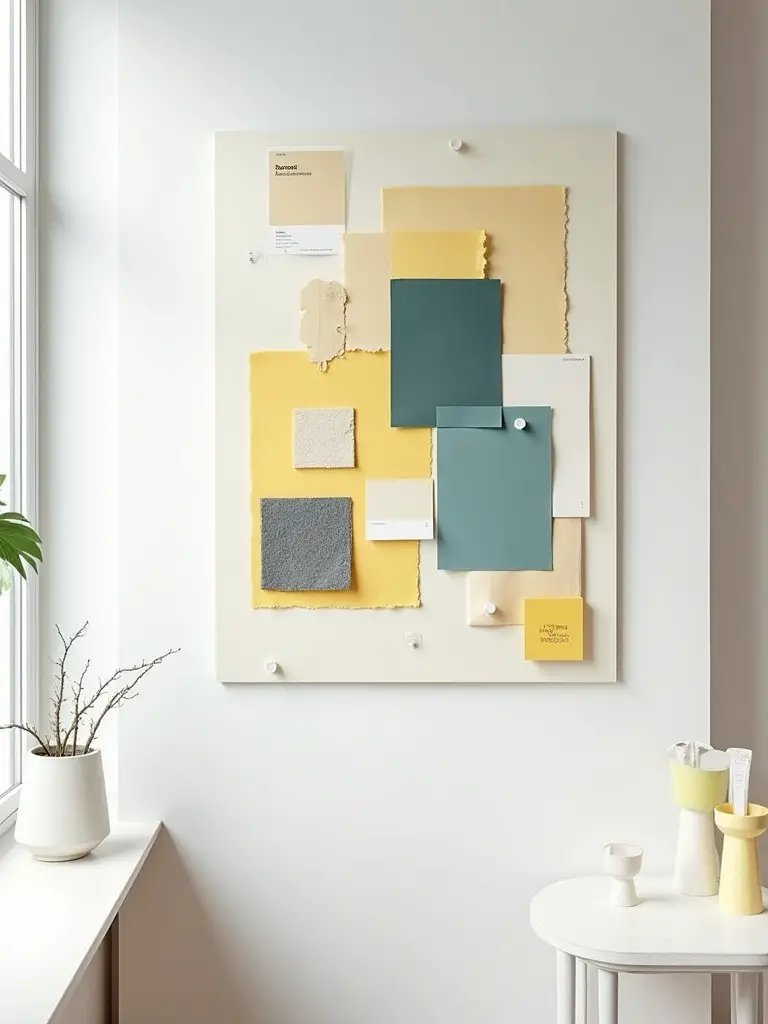
The noise you can ignore is all the digital mood board apps. They’re fine for initial inspiration, but they lie. Screens can’t replicate the way light hits a textured linen versus a cool metal. You need physical samples. Get fabric swatches, wallpaper scraps, wood finish samples, and your large painted swatches. Lay them all out together. Touch them. Move them around in your actual bedroom’s light. This process is what ensures a cohesive, layered, and deeply personal space rather than a collection of nice things that don’t quite speak to each other.
With your mood board solidifying your vision, you can now consider how your color choice will architecturally shape the space itself.
4. Understand How Yellow Influences Room Perception: Enlarging Small Spaces or Brightening Dark Corners
Yellow has a superpower: it reflects more light than any other color on the spectrum, which means you can use it to manipulate the perception of space. In a small or cramped room, a pale, luminous yellow on the walls can visually push them back, making the room feel significantly larger and more airy. It’s a classic trick that works every time. For a room that suffers from a lack of natural light, like a north-facing bedroom or one with a small window, the right yellow can almost mimic sunlight, infusing the space with warmth and brightness.
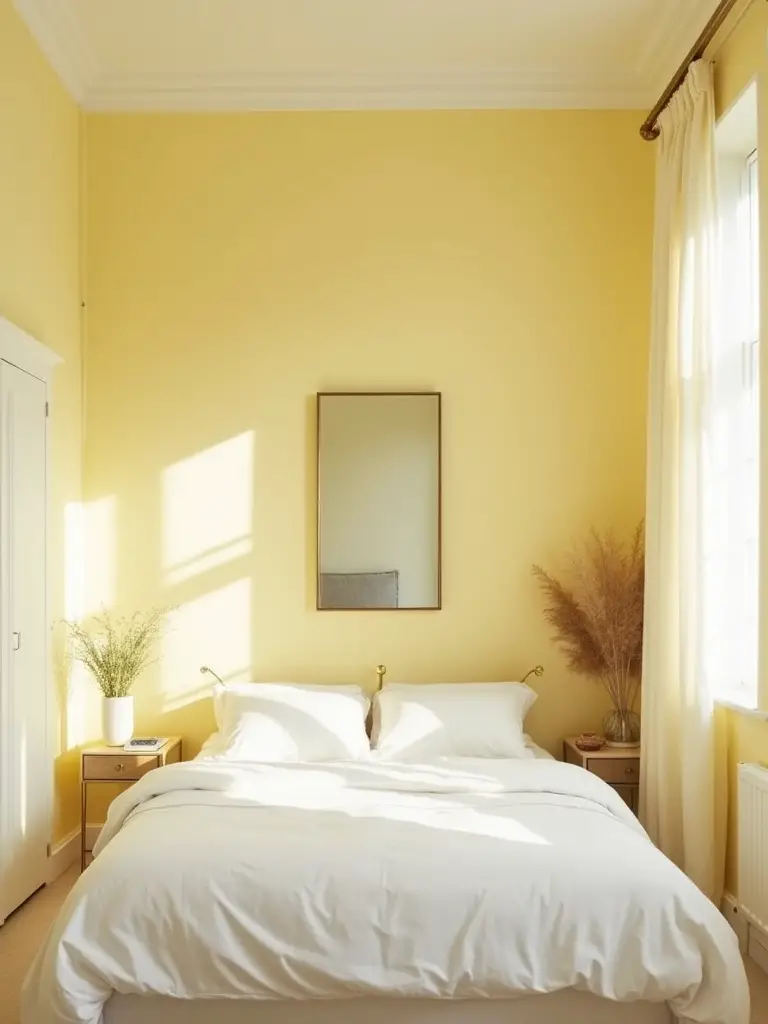
I once worked on a beautiful pre-war apartment in the city, but the guest bedroom was little more than a box with one sad window facing a brick wall. The client wanted it to feel like a cheerful escape. We painted the walls and, crucially, the ceiling in a very soft, creamy yellow with a high Light Reflectance Value (LRV). The result was transformative. The boundaries of the room blurred, and the space felt bathed in a gentle glow, entirely belying its gloomy starting point. The lesson here is that yellow isn’t just decorative; it’s a functional tool for architectural enhancement.
Now we move from the abstract to the concrete: deciding where the star of our show—the yellow—will actually live.
Planning Your Sunny Sanctuary: Laying the Yellow Foundation (Part 2)
We’ve established the why and the what. Now we need to determine the where. You don’t need to drench a room in yellow to feel its effects. Often, the most sophisticated applications are the most focused.
5. Strategically Choose Primary Yellow Areas: Feature Wall, Bedding, or Accessories
The biggest misconception is that using a bold color means you must use it everywhere. On the contrary, restraint is the hallmark of luxury design. Instead of painting every wall, consider making one wall—typically the one behind the headboard—a feature wall. This creates a powerful focal point that anchors the room without overwhelming it. It’s all the impact with half the commitment.
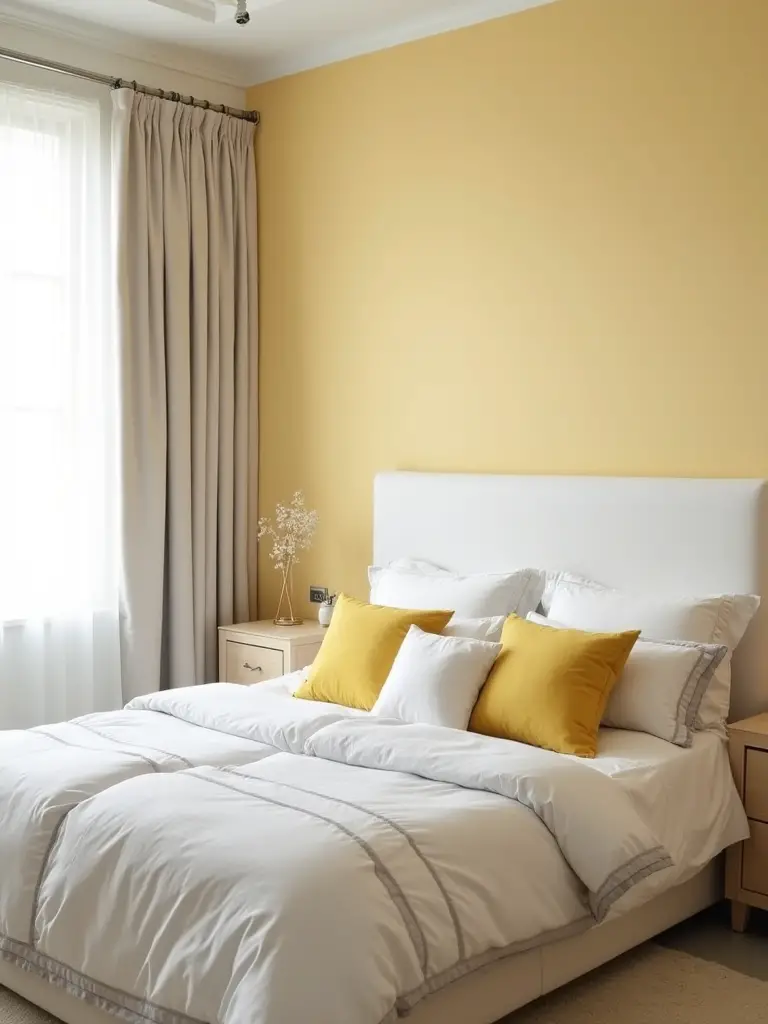
If a painted wall feels like too much, make the bed the primary source of yellow. A gorgeous saffron-hued velvet quilt or a set of crisp lemon-yellow Belgian linen sheets can be the centerpiece of the entire design. The final, and most flexible, approach is to keep your main surfaces neutral and inject yellow through accessories: a pair of statement lamps on the nightstands, a bold piece of Abstract art, or a curated collection of throw pillows. This allows you to play with a vibrant color in a low-stakes, easily changeable way. It’s an investment in flexibility.
Implementing Yellow: Core Elements and Furnishings (Part 1)
With our plan in place, it’s time to execute. The details matter immensely here. The exact finish of your paint or the fabric of your curtains can make the difference between a room that looks fine and one that looks truly exceptional.
6. Select the Perfect Yellow Paint Finish for Durability and Light Reflection
This might sound like a tedious detail, but stay with me, because it’s critical. The sheen of your paint will completely change how your yellow performs. A flat or matte finish absorbs light, giving the color a soft, velvety, and very modern look. It’s beautiful for creating a serene, cocooning feeling, but it’s not very durable and scuffs easily—not ideal for a high-traffic area.
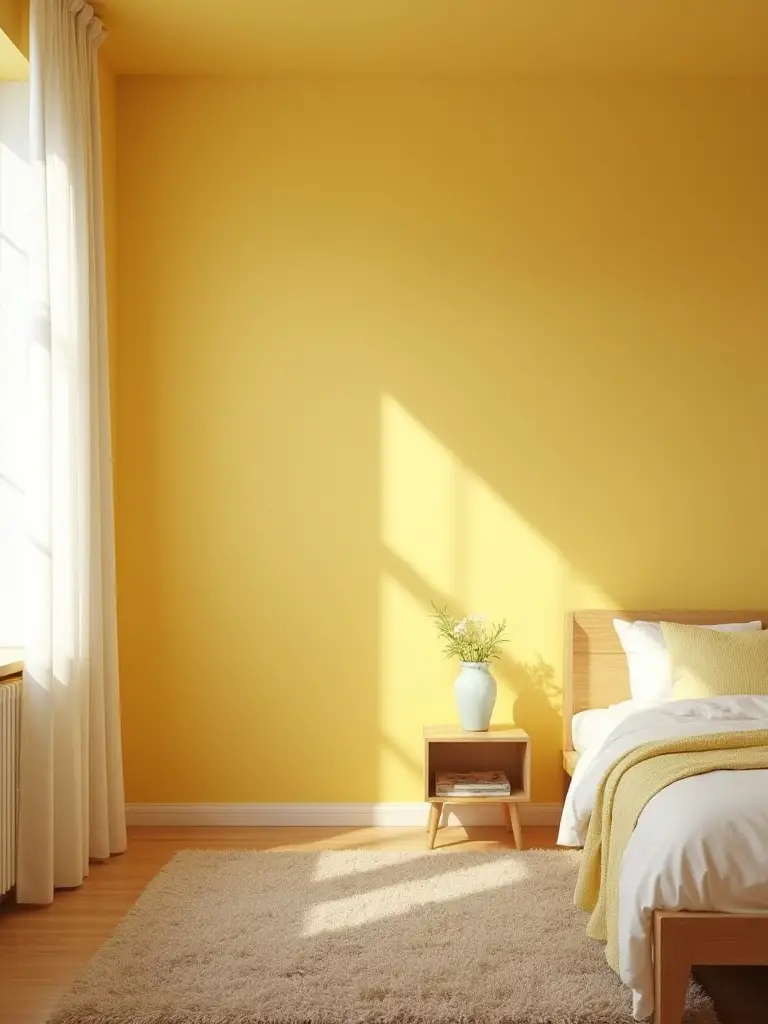
For a bedroom, I almost always recommend an eggshell or satin finish. They have a subtle luster that gently bounces light around the room, enhancing yellow’s natural luminosity without creating a harsh glare. It’s a sophisticated middle ground. A satin finish is also significantly more durable and washable, which is a practical consideration that protects your investment. Never, under any circumstances, should you use a semi-gloss or high-gloss finish on all four walls of a bedroom. The reflection would be relentless and create a jarring, almost nervous energy entirely at odds with a restful sanctuary.
Now that the walls are handled, let’s talk about adding character without adding more paint.
7. Integrate Yellow Through Statement Furniture Pieces Like an Accent Chair or Headboard
One of the most powerful ways to bring in color is through a single, magnificent piece of furniture. Imagine an otherwise serene room of soft greys and creams. Now, place a sculptural accent chair upholstered in a rich mustard yellow velvet in the corner. It’s more than just a chair; it’s a piece of art. It’s a confident, singular statement that elevates the entire space.
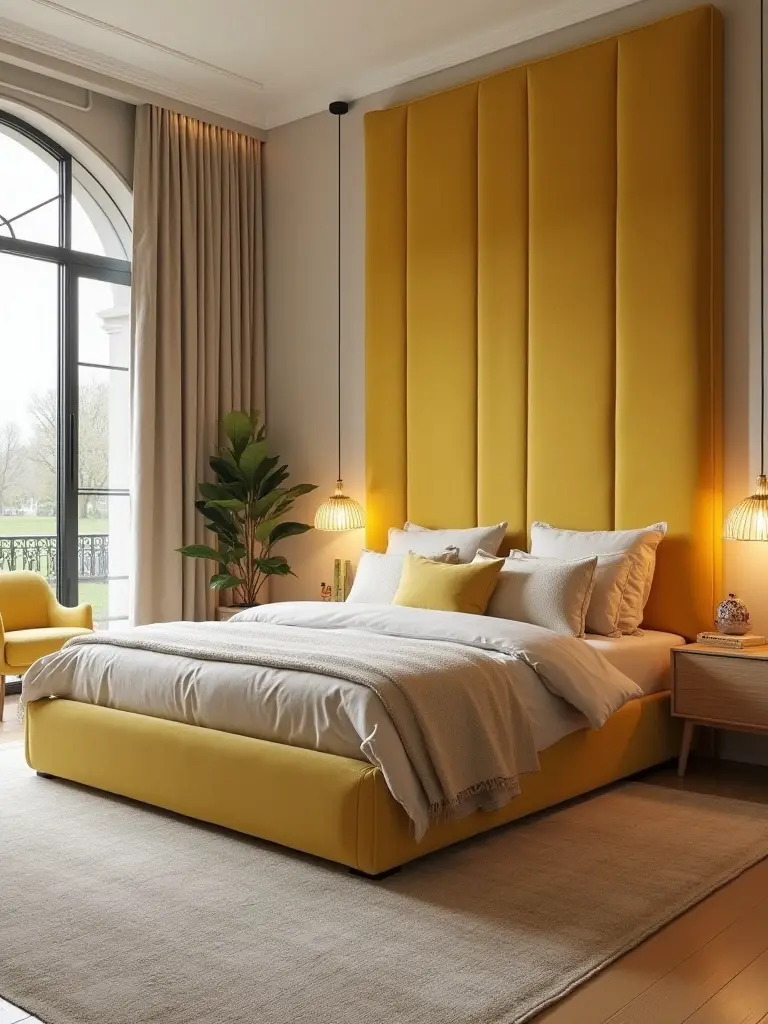
An upholstered headboard is another brilliant vehicle for this. A custom headboard in a stunning marigold patterned fabric can act as the definitive focal point, setting the tone for everything else. This approach is what I call “concentrated impact.” Instead of spreading your color budget thinly across many small items, you invest in one exceptional piece that does all the heavy lifting. It’s a shortcut to a designer look and feels far more curated than scattering yellow accessories everywhere.
Of course, the most central piece of furniture in any bedroom is the bed itself. Let’s make it count.
8. Curate Yellow Bedding: Mix and Match Hues for Layered Visual Interest
Please, step away from the bed-in-a-bag. A truly luxurious bed is never about a perfectly matched set. It’s about a curated collection of textures and tones. When working with yellow, this is your opportunity to create incredible depth. Start with a foundational piece, perhaps a soft buttercup yellow duvet cover in washed linen. Then, layer on top of it. Add a pair of Euro shams in a deeper, more golden hue. A lumbar pillow in a saffron velvet. And maybe a chunky knit throw blanket in a pale, creamy chartreuse draped at the foot.
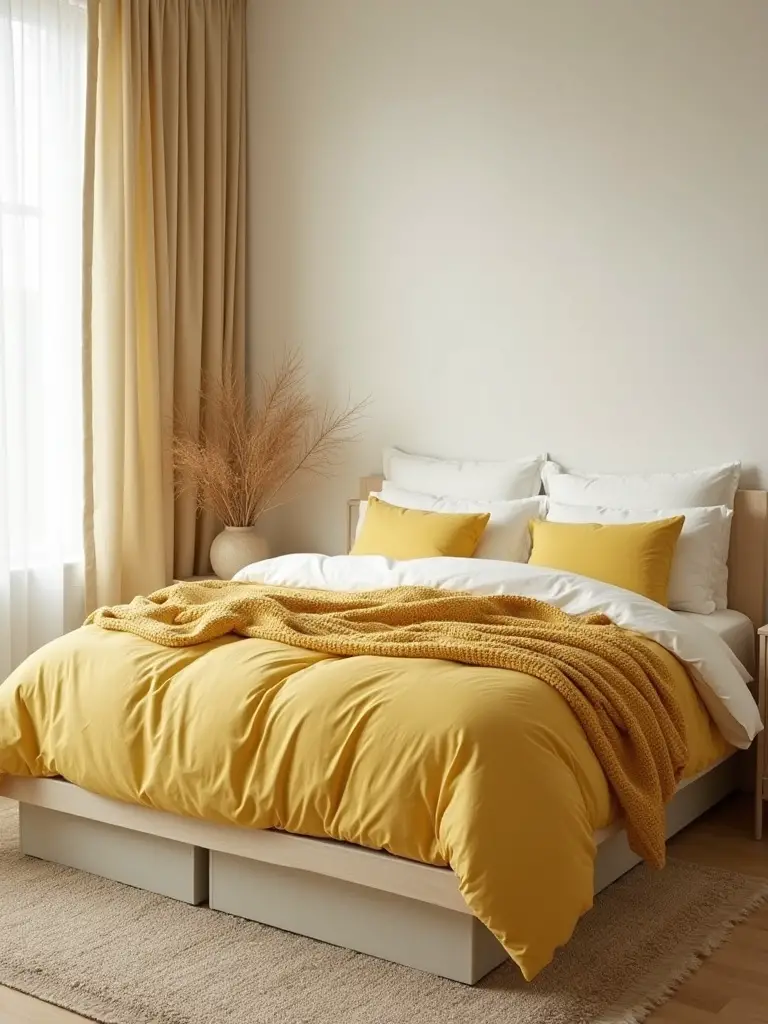
See how that works? You’re not just using “yellow”; you’re telling a story with it. By mixing shades from the same color family and introducing a variety of textures—smooth cotton, rumpled linen, plush velvet, nubby knit—you create a bed that you don’t just want to look at, you want to dive into. It’s the difference between a bed that looks nice and one that feels undeniably inviting and sophisticated.
Let’s not forget the elements that frame our view of the world—and the room.
9. Incorporate Yellow Window Treatments to Control Light and Add Softness
Window treatments are often an afterthought, but they are one of the most transformative elements in a room. Using yellow here can be magical. Imagine sheer linen curtains in a pale straw yellow. During the day, they will filter the sunlight, casting a warm, beautiful glow across the entire room. It’s like living inside a permanent golden hour.
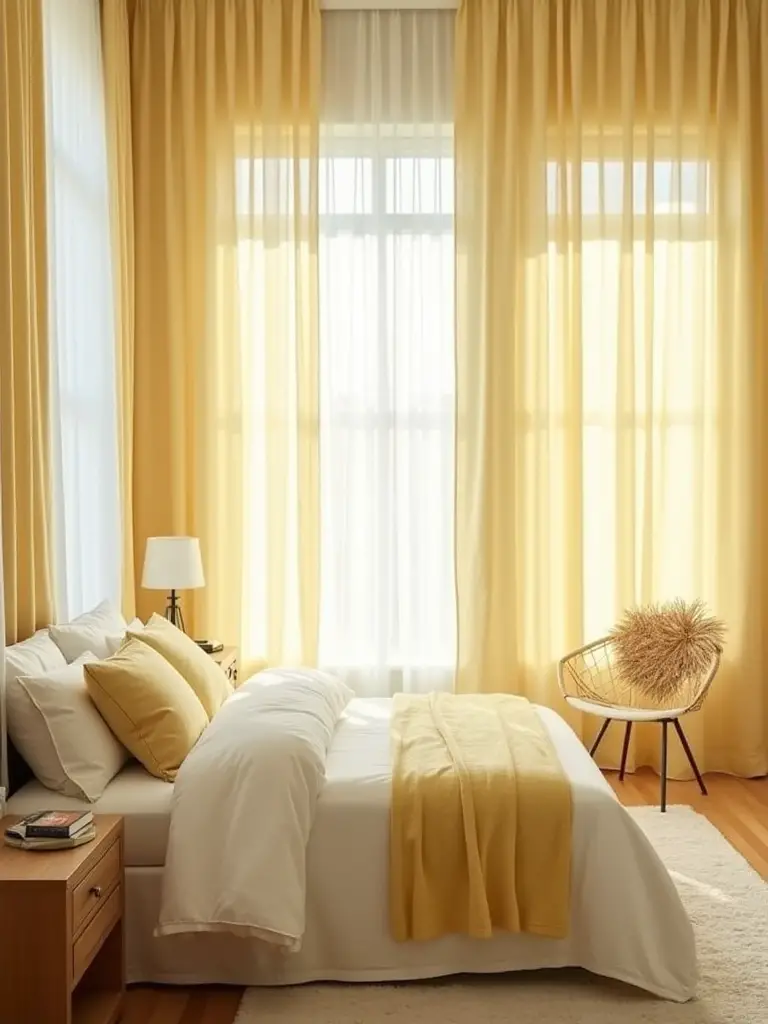
For a more dramatic and formal look, consider custom drapes in a heavier fabric, like a silk or velvet, in a deep gold or mustard. Hung properly—high and wide to frame the window—they add a sense of grandeur and opulence. And don’t ignore function. If you need blackout capabilities for sleep, you can have a blackout liner added to any decorative fabric. Your window treatments should be a perfect marriage of beauty and utility, softening the hard architectural lines of the window and completing the room’s color story.
With the core soft furnishings decided, we must address the foundation that everything rests upon.
Implementing Yellow: Core Elements and Furnishings (Part 2)
A vibrant color like yellow needs a steady, calm foundation. This next step is all about creating the perfect counterpoint to ensure your design feels balanced, not chaotic.
10. Pair Yellow Walls with Neutral Flooring Options to Ground the Space
If you’ve decided on yellow walls, you absolutely must ground them with neutral flooring. This is the visual anchor that keeps the entire room from feeling like it’s about to float away. A vibrant wall needs a calm floor to rest upon. Think of Natural materials and quiet tones: light oak hardwood, a soft beige wool carpet, or even a sophisticated pale grey polished concrete.
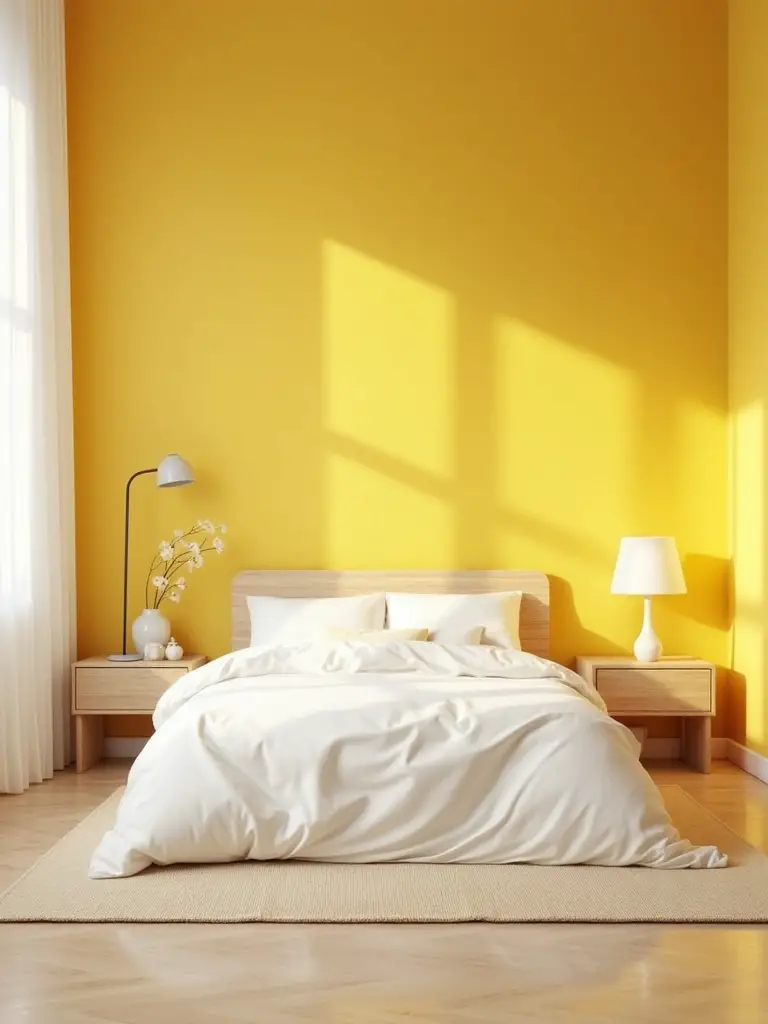
The noise you hear about needing to match wood undertones perfectly is mostly just that—noise. What truly matters is creating a distinct contrast in tone and energy. The active, warm energy of the yellow walls is beautifully balanced by the quiet, stable presence of a neutral floor. A rich walnut floor can look stunning with mustard walls, just as a pale maple can complement a lemon yellow. The goal is balance, providing a serene stage upon which your vibrant color can truly sing without becoming shrill.
Styling and Enhancing with Yellow Accents
This is the finishing layer—the jewelry of the room. It’s where you add personality and tie everything together. These small touches are what make a space feel complete and thoughtfully curated.
11. Introduce Textural Variety with Yellow Throw Pillows and Cozy Blankets
Just as with bedding, accessories are an opportunity to play with texture. This is what gives a room its soul. Don’t just buy a yellow pillow; find a yellow pillow in a boucle fabric, another in a raw silk, and a third in a soft, brushed cotton. Place them next to each other. Layer a fine-gauge cashmere throw over a chunky cable-knit blanket.
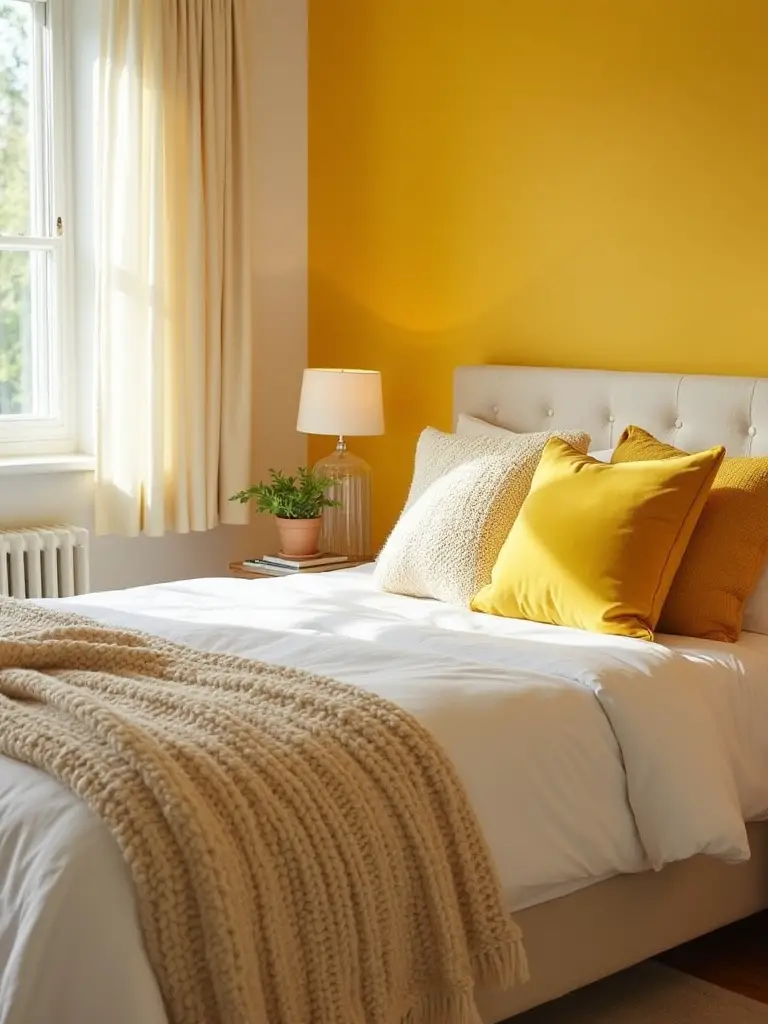
This multi-sensory approach is a hallmark of high-end design. It’s not just about what you see; it’s about what you imagine touching. It creates a rich, inviting environment that feels layered over time, not decorated in an afternoon. These textural elements prevent your color scheme from feeling flat or one-dimensional, adding a crucial layer of sophistication.
Moving from tactile to visual, let’s address the walls in a way that feels more personal than paint.
12. Adorn Walls with Art Prints Incorporating Yellow for Visual Cohesion
Art is not a placeholder. It is a vital part of the conversation in a room. If you have yellow accents in your textiles, echoing that color in your wall art is a sophisticated way to create visual cohesion. This doesn’t mean you need a painting of a sunflower. Look for abstract pieces with a slash of ochre, a landscape with a golden sunset, or even black-and-white photography presented in a warm brass frame.
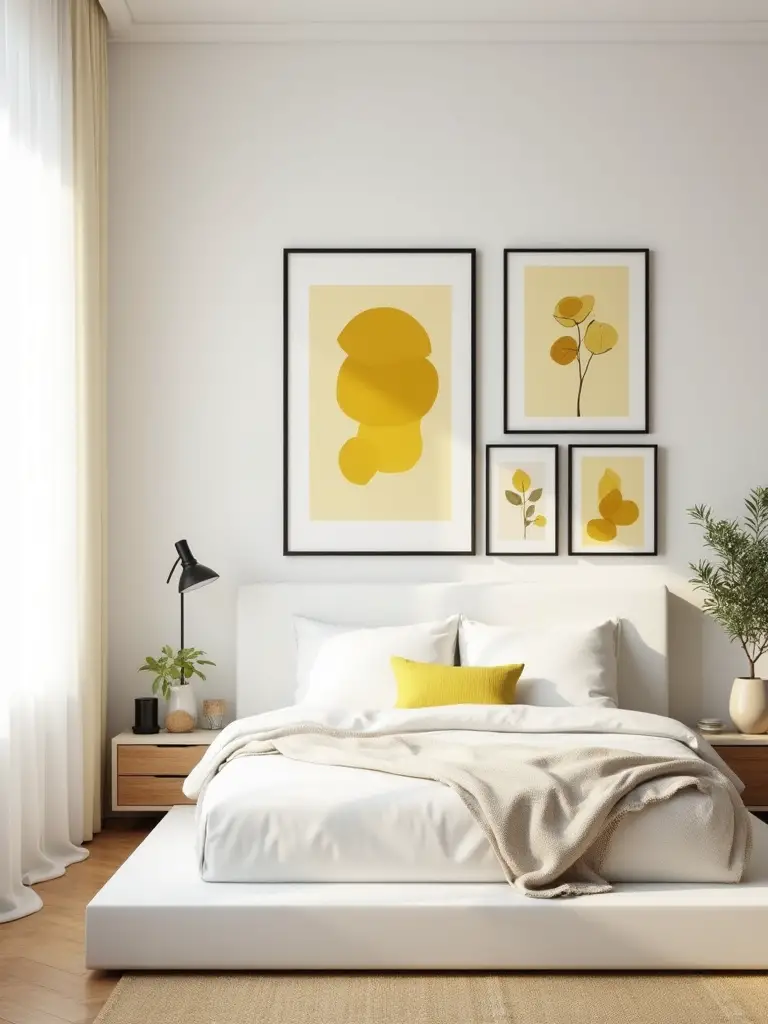
A well-chosen piece of art can tie all the disparate elements of your room together. It validates your color choice and makes it feel intentional. I always advise clients to invest in one piece of art they truly love rather than a dozen cheap prints. That one piece will bring more joy and elevate the space more effectively than any amount of mass-produced decor. It’s about quality and connection, not just filling a blank space.
Let’s bring a little life into the room—literally.
13. Brighten Corners with Live Plants in Yellow Ceramic Planters
Every room needs something living. It adds a natural, organic element that prevents a space from feeling too sterile or staged. Placing a beautiful plant, like a Fiddle Leaf Fig or a Snake Plant, in a forgotten corner instantly brings it to life. And housing it in a gorgeous yellow ceramic planter is the perfect way to carry your color story into that corner.
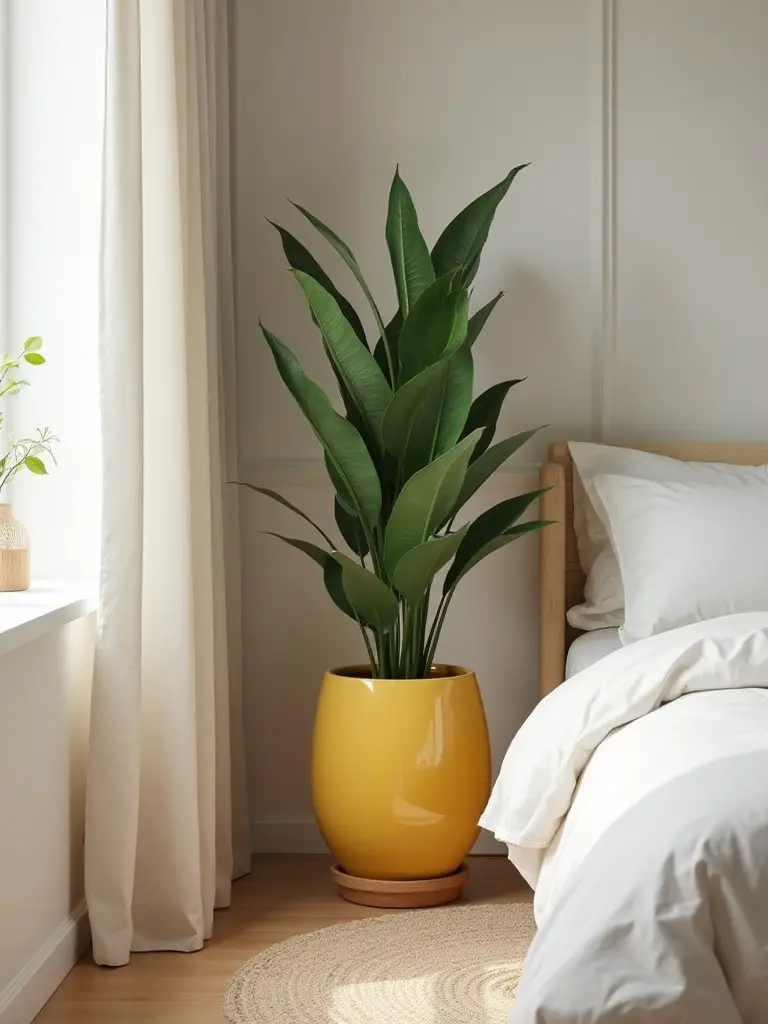
This is a simple, high-impact move. You can find stunning ceramic planters at every price point, from artisan pottery studios to retailers like West Elm or CB2. Choose a planter in a shade of yellow that complements your palette—a glossy lemon for a modern room, or a matte, earthy terracotta-yellow for a more bohemian space. It’s a small detail that makes a huge difference, adding a pop of color, texture, and life all at once.
And finally, for a touch of brilliance…
14. Utilize Metallic Accents Like Gold or Brass to Elevate Yellow’s Sophistication
Yellow and warm metals are a match made in design heaven. Gold, and particularly brass, share the same warm undertones as yellow and amplify its luxurious qualities. This is what takes a yellow room from simply “cheerful” to undeniably “chic.” The reflective quality of metal adds a touch of glamour and helps bounce light around the room.
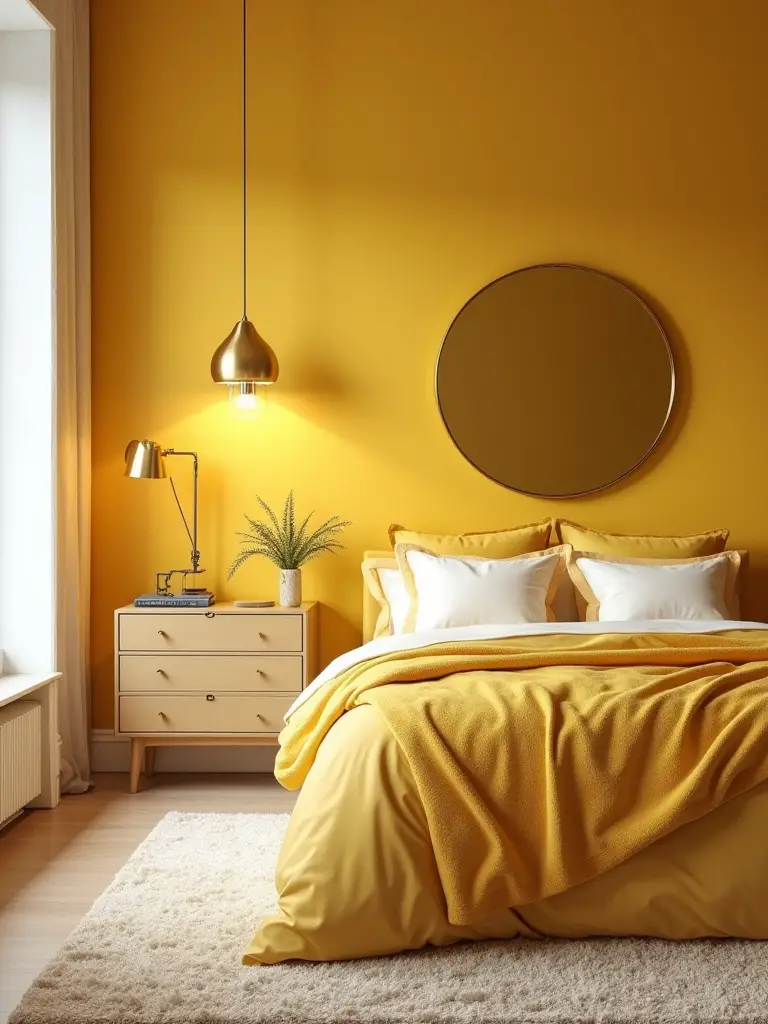
Incorporate these metals thoughtfully. A slender brass floor lamp next to a reading chair, a gold-framed mirror over the dresser, or even just swapping out standard drawer pulls for elegant brass hardware. I particularly love using unlacquered brass, which develops a beautiful, rich patina over time. It adds a sense of history and soul to a room. This pairing of yellow and brass is a timeless combination that signals quality and refinement.
Advanced Yellow Applications and Harmonious Touches
Now we’re getting into the nuanced techniques that separate a good room from a truly great one. These are the details that create mood, solve problems, and ensure your space feels harmonious and dynamic.
15. Employ Smart Lighting Choices to Highlight Yellow Features and Create Ambiance
Lighting is everything. You can have the most exquisitely designed room, but if the lighting is flat and harsh, it will fall apart. With a yellow room, smart lighting is a game-changer because you can adjust the color temperature. In the morning, you can program your lights to a cooler, brighter white to energize the space and make your yellows feel crisp and clean. In the evening, you can shift to a warm, dim glow (around 2700K) that makes your yellow walls feel rich, cozy, and enveloping.
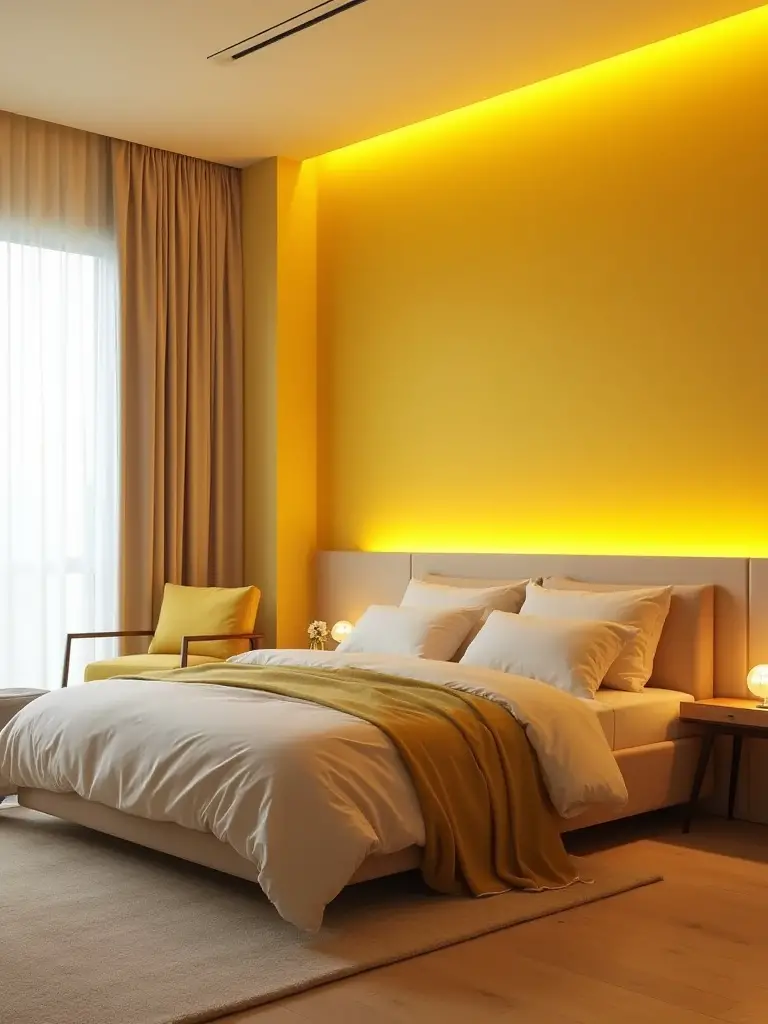
“Adjusting the Correlated Color Temperature (CCT) of your lighting is paramount… A warmer CCT can make yellows feel richer and more inviting, while cooler tones might emphasize brightness.”
Consider using smart LED strips behind a headboard to cast a wash of light up a feature wall or placing smart bulbs in your bedside lamps. This level of control allows you to tailor the ambiance of your room to the time of day and your specific mood. It’s a dynamic approach to design that makes the space work for you.
To ensure all this beautiful light and color doesn’t become too much of a good thing, we need to talk about balance.
16. Prevent Overwhelming the Space by Strategically Balancing Yellow with Cooler Tones
For yellow to truly shine, it needs a counterpart. Introducing cooler tones—like slate gray, deep navy blue, or even a soft sage green—provides a necessary visual balance. This keeps the yellow from becoming overwhelming and adds a layer of sophistication. A warm color advances visually, while a cool color recedes. Using both creates a pleasing tension and depth.
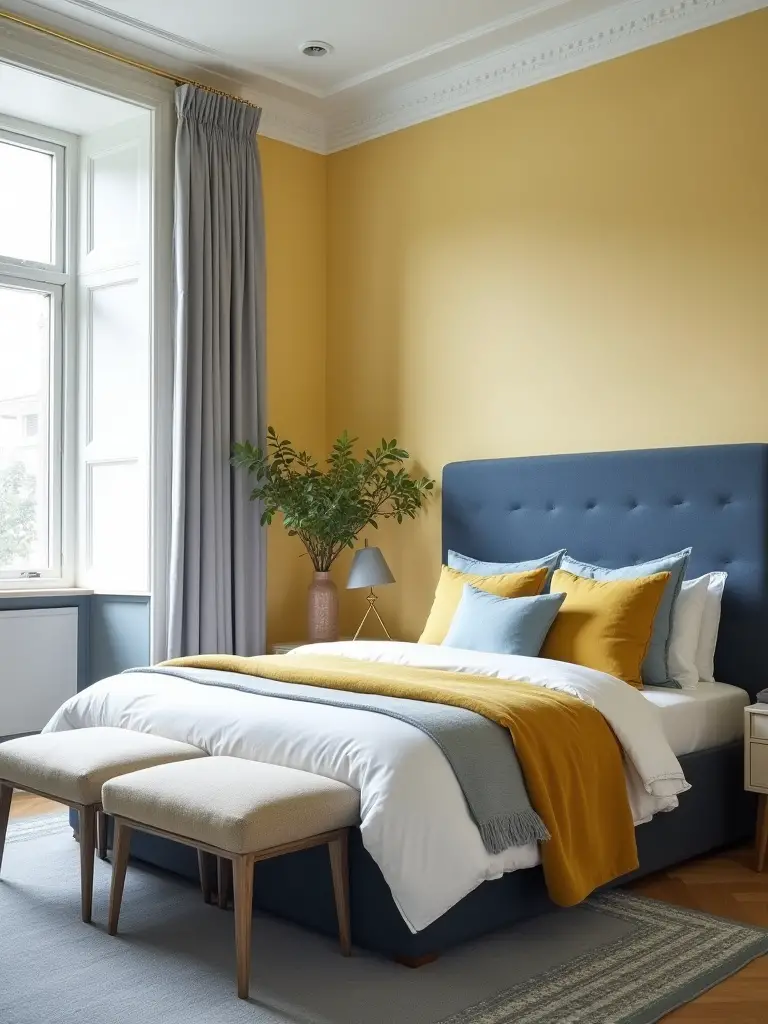
You don’t need to follow a rigid 60-30-10 rule, but the principle is sound. If your walls are a soft yellow, consider a charcoal grey upholstered bed or navy blue curtains. If your primary color is a cool grey, then bring in yellow as your powerful accent. This high-contrast pairing feels confident and intentional. It shows you understand how colors interact, rather than simply choosing one you like and using it everywhere.
Next, a trick to make any space feel more expansive and brilliant.
17. Integrate Mirrored Surfaces to Amplify Yellow Light and Space Perception
A large, well-placed mirror is one of the oldest and most effective tricks in the design book. In a yellow room, its power is magnified. A mirror placed opposite a window will capture the natural light and bounce it, along with the warm yellow hue, all around the room. It essentially doubles your light source and makes the space feel larger, brighter, and more alive.
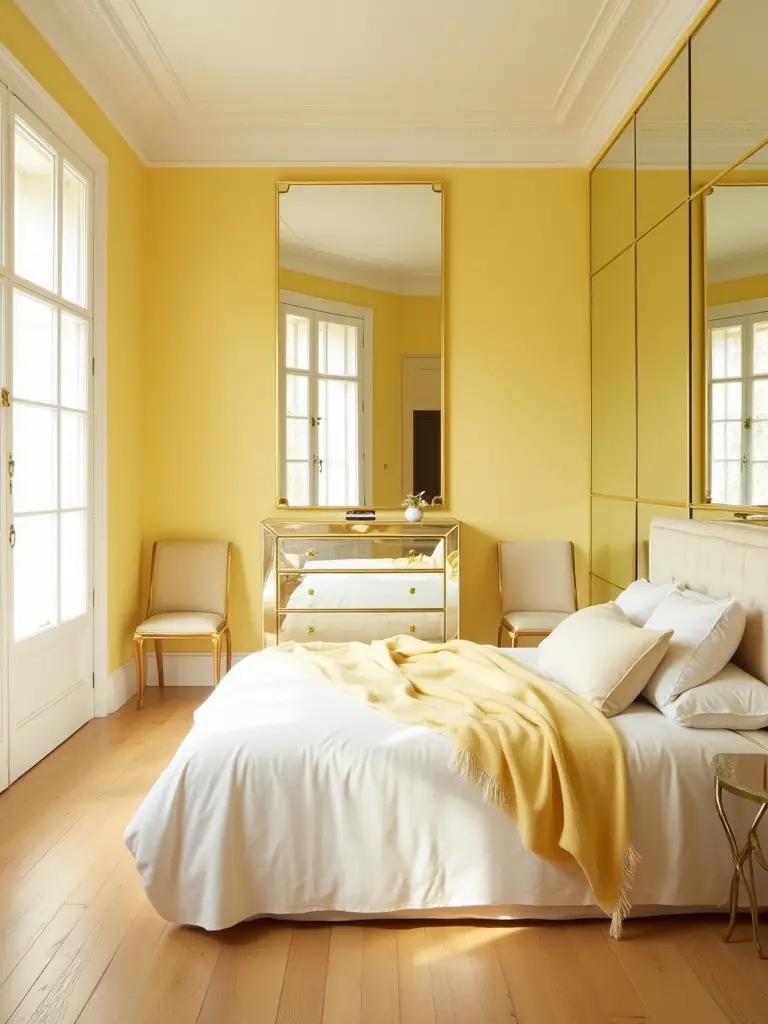
Don’t just hang a small, decorative mirror. Think big. A full-length floor mirror leaning against a wall adds a casual elegance. Mirrored wardrobe doors can make a small room feel twice its size. Even smaller touches, like a mirrored tray on a dresser or mirrored nightstands, add little pockets of reflection and glamour that elevate the entire room. It’s a simple addition with a dramatic impact.
Finally, let’s make sure your beautiful room never feels stale.
18. Refresh with Seasonal Yellow Accents to Easily Update Your Bedroom’s Look
The beauty of using yellow in your smaller, more transient decor is the ease with which you can adapt your space to the seasons. Your primary investment pieces—the bed, the flooring, the wall color—can remain constant. But the smaller touches can change with your mood and the time of year.
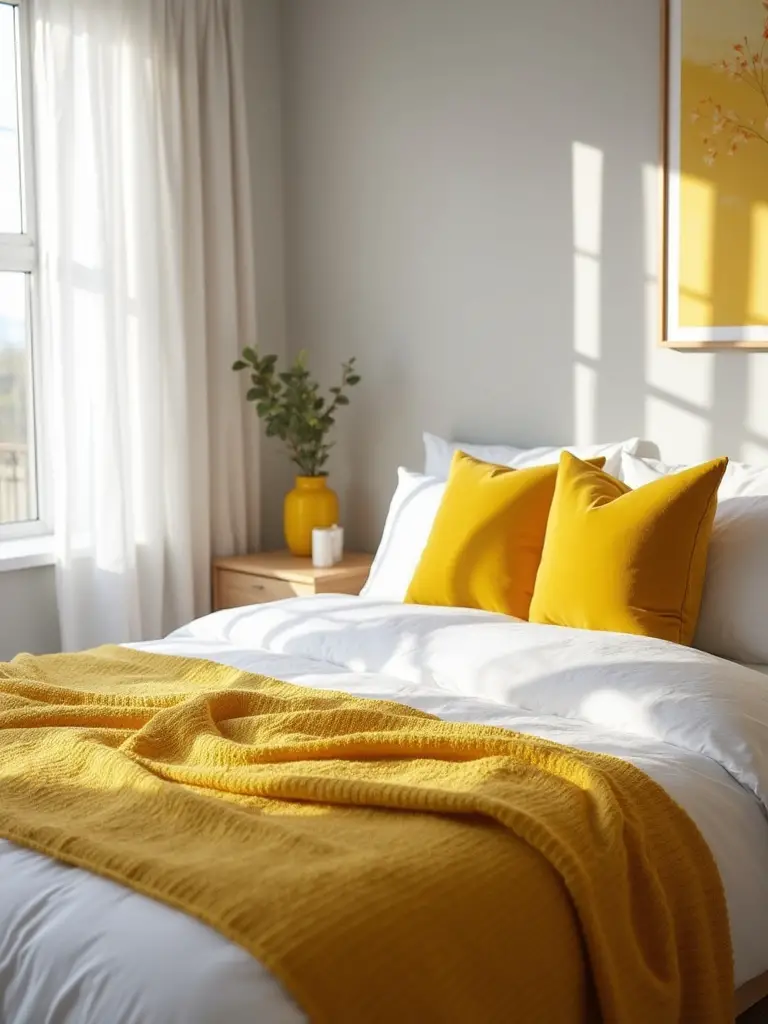
In the spring and summer, bring in pillows and throws in bright, zesty lemon and daffodil yellows. Add a vase of fresh sunflowers. For autumn and winter, swap those out for cozier textures in deeper tones—a mustard velvet pillow, a golden chenille throw, a bouquet of dried grasses. This simple act of rotating a few key accessories keeps your bedroom feeling fresh, dynamic, and perpetually stylish without requiring a major overhaul. It’s the ultimate smart design investment.
Conclusion
So, you see, creating a truly luxurious yellow bedroom has very little to do with just picking a color and painting the walls. It’s about understanding light, exercising restraint, and curating a thoughtful blend of texture, tone, and personal touches. Yellow is not a color to be afraid of; it’s a powerful tool to be wielded with intention. It can be serene, vibrant, cozy, or sophisticated—whatever you ask of it.
Your bedroom is your sanctuary, the first thing you see in the morning and the last thing you see at night. It should be a reflection of your best self—optimistic, warm, and confident. Don’t just settle for a room that’s simply “decorated.” Use these ideas to create a space that doesn’t just look beautiful, but feels profoundly right. A space that makes you happy to be home.
